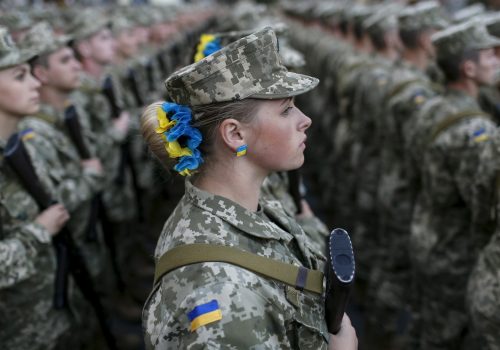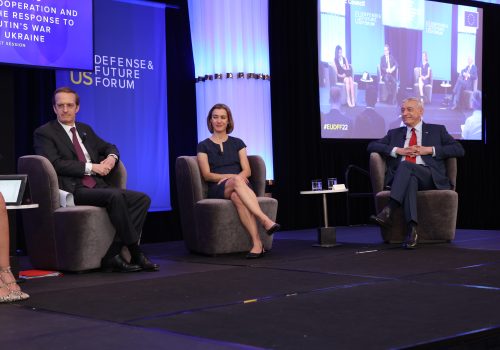Advancing a framework for the stabilization and reconstruction of Ukraine
Introduction
Russia’s illegal and unprovoked war on Ukraine has shattered peace on the European continent and created tectonic shifts in the transatlantic security architecture. The Kremlin’s invasion has decimated Ukraine’s economy and infrastructure, and left tens of thousands of innocent civilians wounded or dead as part of a war-crime ridden military campaign.
At the time of writing, Kyiv is making slow advances in the South and East with the help of significant Western military and economic aid, yet the outcome of the conflict continues to hang in the balance. A prolonged stalemate and some variation of a negotiated settlement seem most likely, with a Russian victory remaining a distant possibility.1Alan Yuhas, “Thousands of Civilian Deaths and 6.6 Million Refugees: Calculating the Costs of War,” New York Times, August 24, 2022, https://www.nytimes.com/2022/08/24/world/europe/russia-ukraine-war-toll.html#link-6db0e8a.
Absent an absolute Kremlin victory, Ukraine will need to stabilize vast swathes of its territory and reconstruct the social and industrial infrastructure therein.2We define an absolute Kremlin victory in Ukraine as Russia overthrowing the government in Kyiv. Due to their proximity to Ukraine and long-standing economic, political, and social connections, transatlantic allies and partners will most likely be deeply involved in this effort and will be significantly affected by its end result.
The purpose of this issue brief then is to help Ukrainian, North American, and European policymakers consider stabilization and reconstruction needs and have a playbook in place regardless of the circumstances or outcome.
The international community is understandably focused on funneling short-term military support to make sure its beleaguered partner wins a still uncertain war. The United States and its allies can and should do more on this front. Yet discussing needs and discerning an associated framework for the stabilization and reconstruction of Ukraine now is crucial for two major reasons.
First, proactive planning efforts can avoid a scenario where the United States, Europe, other allies and Ukraine approach stabilization haphazardly, and primarily as an immediate-term humanitarian response rather than a targeted political initiative linked to longer-term development. Lessons-learned analyses from other stabilization and reconstruction contexts suggest that a lack of appropriate planning led to significant negative downstream consequences that undermined the success of the mission, such as misallocation of resources or exacerbation of conflict dynamics.3We use the US government definition of stabilization: “as a political endeavor involving an integrated civilian-military process to create conditions where locally legitimate authorities and systems can peaceably manage conflict and prevent a resurgence of violence. Transitional in nature, stabilization may include efforts to establish civil security, provide access to dispute resolution, deliver targeted basic services, and establish a foundation for the return of displaced people and longer-term development.” See Stabilization Assistance Review: A Framework for Maximizing the Effectiveness of U.S. Government Efforts to Stabilize Conflict-Affected Areas, US Departments of State and Defense and USAID, January 2018, https://www.state.gov/wp-content/uploads/2019/06/SAR-Final.pdf; regarding mistakes made by past stabilization operations in Afghanistan, see Special Inspector General for Afghanistan Reconstruction (SIGAR), What We Need to Learn: Lessons from Twenty Years of Afghanistan Reconstruction, August 2021, https://www.sigar.mil/interactive-reports/what-we-need-to-learn/. Second, an early, proactive, and structured commitment to helping Ukraine in its reconstruction can prevent downstream compounding crises. For instance, tackling proactively the issue of refugees and the return of internally displaced persons (IDPs) can ensure the Ukrainian state is prepared to provide the services they need upon arrival, and can avoid the negative consequences that the lack of consistent access to educational, mental health, and medical resources can have on populations.4“Returns Increase in Ukraine, but 6.2 Million People Remain Internally Displaced,” International Organization for Migration (website), June 28, 2022, https://www.iom.int/news/returns-increase-ukraine-62-million-people-remain-internally-displaced. Forward planning can help make sure actionable plans for restarting the economy are in place when conditions permit.
Ultimately, the cost of a flawed intervention in Ukraine (or worse yet, inaction) is too high to bear for the transatlantic community.5Ray Salvatore Jennings, “The Risks and Rewards of Planning for Ukraine’s Recovery amid Ongoing War,” Just Security (online forum based at New York University School of Law), September 29, 2022, https://www.justsecurity.org/83249/the-risks-and-rewards-of-planning-for-ukraines-recovery-amid-ongoing-war/?s=09. US and European decision makers have long stated that Ukraine’s fight is not only for its own future, but for that of the transatlantic community.6Among the numerous speeches made by President Biden and European leaders, see, for example, “Remarks by President Biden on the United Efforts of the Free World to Support the People of Ukraine,” White House Briefing Room (website), Remarks in Warsaw, March 26, 2022, https://www.whitehouse.gov/briefing-room/speeches-remarks/2022/03/26/remarks-by-president-biden-on-the-united-efforts-of-the-free-world-to-support-the-people-of-ukraine/. Not helping to restore Ukraine’s political vibrancy, economic activity, and security institutions would be an unforgivable mistake that could undermine the rules-based international order and open up new avenues for authoritarian leaders to exploit the current context.
With that aim in mind, this policy brief articulates an actionable and evidence-based framework for the stabilization and reconstruction of Ukraine. It begins by assessing the impact of the Russian invasion on the Ukrainian state and citizenry, with a focus on identifying priority needs for stabilization efforts. It then situates these needs with an analysis of the overall geopolitical environment and its implications for international stabilization efforts.
Based on an analysis of the intra-Ukraine and international contexts, the paper then articulates the goals and limits of potential stabilization and reconstruction efforts, centering on prospects to strengthen political order, economic vibrancy, and social cohesion, which should be priorities no matter the outcome of the conflict. The brief concludes with policy recommendations for stabilization under three of the most probable scenarios for the trajectory of the conflict.
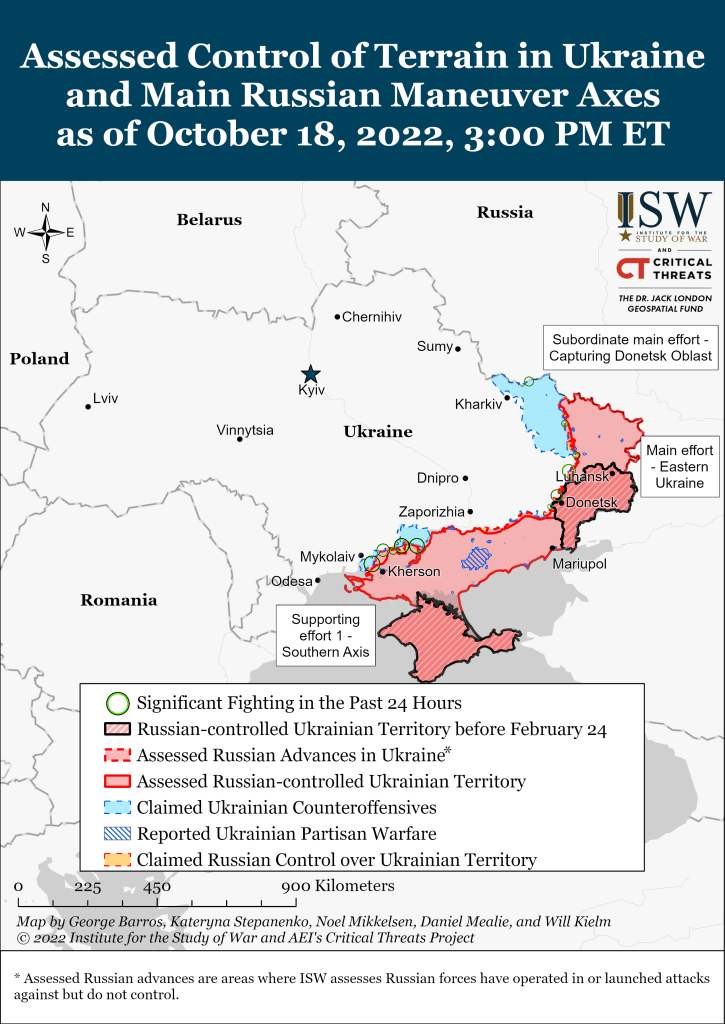
The Russian invasion and implications for stabilization and reconstruction
The impact of Russia’s war is being felt globally. A fast-escalating refugee crisis has resulted in over 7.4 million fleeing Ukraine since February 2022, with another seven million displaced internally.7United Nations High Commissioner for Refugees (UNHCR), Operational Data Portal, Ukraine Refugee Situation, accessed October 2022, https://data.unhcr.org/en/situations/ukraine; see also “Internally Displaced Persons (IDPs),” UNHCR Ukraine website, accessed October 2022, https://www.unhcr.org/ua/en/internally-displaced-persons. The armed violence has disrupted the global supply of fertilizers, petroleum, wheat, barley, corn, and cooking oil. Disruptions have driven up prices and inflation—from Sri Lanka to Peru—as well as forced devaluations in several currencies. Geopolitically, the war has resulted in a reinvigorated NATO—with Finland and Sweden applying for formal membership—as well as reevaluation of defense postures in Australia, Moldova, Finland, Poland, North Korea, Germany, the United Kingdom, Estonia, Sweden, and the United States.8For a synthesis of the impact of the Russian invasion on Ukraine, see Alina Selyukh et al., “The Ripple Effects of Russia’s War in Ukraine Are Changing the World,” Ukraine Invasion—Explained (special series), National Public Radio, May 10, 2022, https://www.npr.org/2022/05/10/1093066817/ukraine-war-gas-prices-refugees.
The most direct and immediate effects of the Russian invasion have of course been in Ukraine itself. Estimates indicate the reconstruction of Ukraine will require $349 billion to $1 trillion,9Estimates on the cost of reconstruction for Ukraine range from $750 billion to €1 trillion ($1.1 trillion), per June statements by Ukraine Prime Minister Denys Shmyhal and European Investment Bank President Werner Hoyer, respectively; in early September, the European Commission, the World Bank, and the Ukraine government estimated the total current cost of reconstruction and recovery at $349 billion. See Dan Bilefsky and Nick Cumming-Bruce, “Ukraine’s Prime Minister Says Rebuilding Will Cost $750 Billion,” New York Times, July 5, 2022, https://www.nytimes.com/2022/07/05/world/europe/ukraines-prime-minister-says-rebuilding-will-cost-750-billion.html; Steven Arons, “Ukraine Reconstruction May Cost $1.1 Trillion, EIB Head Says,” Bloomberg, June 21, 2022, https://www.bloomberg.com/news/articles/2022-06-21/ukraine-reconstruction-may-cost-1-1-trillion-eib-head-says#xj4y7vzkg; and World Bank, “Ukraine Recovery and Reconstruction Needs Estimated $349 Billion,” Press Release, September 9, 2022, https://www.worldbank.org/en/news/press-release/2022/09/09/ukraine-recovery-and-reconstruction-needs-estimated-349-billion. with those numbers likely to grow. Violence has decimated Ukraine’s infrastructure including but not limited to major roadways and intracountry transport arteries; key bridges; social service infrastructure; telecommunications; and industry. The invasion has constrained Ukraine’s economy, leading to a projected contraction of 35 percent this year due largely to a drop in exports of manufactured goods and foodstuffs.10For more details, see World Bank, “Russian Invasion to Shrink Ukraine Economy by 45 Percent This Year,” Press Release, April 10, 2022, https://www.worldbank.org/en/news/press-release/2022/04/10/russian-invasion-to-shrink-ukraine-economy-by-45-percent-this-year. Ukraine’s already vast budget deficit is expanding, with an expected $38 billion gap in 2023 mainly covered by the International Monetary Fund, the United States, and the European Union.11Kyiv bureau and Gareth Jones, “Ukraine Budget Deficit Seen at $38 Bln in 2023-Interfax Quotes PM,” Reuters, September 14, 2022, https://www.reuters.com/world/europe/ukraine-budget-deficit-seen-38-bln-2023-interfax-quotes-pm-2022-09-14/. The conflict has reduced or eliminated basic services for large portions of the population, from clean drinking water to education. Ripped from their homes or simply unable to provide for themselves or their families, millions of Ukrainians have sought temporary refugee status across Europe.12For a breakdown of the countries in which Ukrainians are seeking temporary refugee status, see “How Many Ukrainian Refugees Are There and Where Have They Gone?,” BBC, July 4, 2022, https://www.bbc.com/news/world-60555472.
Underscoring these immediate effects is Ukraine’s massive and ever-growing loss of human life—whether armed forces, civilians-turned military recruits, or civilians.13Yuhas, “Thousands of Civilian Deaths and 6.6 Million Refugees.” This loss of life is a moral catastrophe. It will also make even more difficult discerning solutions to the short- and long-term challenges, all of which require human capital to execute.
But there are searing indirect effects, too. Internal displacement of the population, massive brain drain as large groups flee the country and become refugees, and potentially weakening social cohesion in the long term,14Ray Salvatore Jennings, “War’s Aftermath in Ukraine: Preparing Now for the Day After,” Just Security, May 5, 2022, https://www.justsecurity.org/81379/wars-aftermath-in-ukraine-preparing-now-for-the-day-after/. as armed hostilities often constrain opportunities for longer-term perspective that is fundamental for building a sense of cohesive identity.
| Refugees from Ukraine recorded across Europe | 7,710,924 |
| Refugees from Ukraine registered for Temporary Protection or similar national protection schemes in Europe | 4,386,102 |
Other indirect effects of the invasion will manifest in the medium- to long-term unless the government, with international support, takes steps to address their precursors now. Some of these are distinct while others would represent the worsening of short-term impacts. Infrastructure repair and rebuilding will take years. Progress on this front will influence reactivation of local supply chains, industry, and job prospects for civilians. Longer-term effects include educational loss of school-age children unable to attend class because of hostilities. The short-term need to rebuild as soon as possible will be weighed against reimagining Ukrainian metropolises to be more modern, sustainable, and inclusive.
The geopolitical environment: Challenges for stabilization and reconstruction
The crisis in Ukraine has galvanized the West unlike any geopolitical issue since the end of World War II. This mobilization, orchestrated by the United States, NATO, and the European Union, has resulted in a significant amount of assistance for the Ukrainian state and people, a concerted effort to punish Russia through biting sanctions, and a reinforcement of the transatlantic security and defense architecture. It has helped in decisively blunting the Russian invasion and escalated the cost of war for Russia.
Yet, the United States and allies face two main geopolitical challenges to resourcing, coordinating, and executing a stabilization and reconstruction program that will resuscitate Ukraine’s government and economy. The first of these is the competition to shape the parameters of international order between the United States and Europe, on one side, and China and Russia, on the other. The second pertains to marshaling a collective and enduring commitment, in the West, for stabilization in Ukraine in the face of mounting domestic pressures—spiraling inflation and surging energy prices chief among them—exacerbated by lingering questions about the efficacy of large-scale stabilization and reconstruction given the less than promising outcomes in Afghanistan and Iraq.
A competition of systems: Attempts to undermine the international order
The People’s Republic of China (PRC), under President Xi Jinping, and Russia are working to replace an international order grounded in tenets of openness, freedom, and respect for territorial integrity with one that favors authoritarianism. Russia’s invasion of Ukraine—preceded by the Xi-Putin announcement of a “friendship with no limits”— brings into stark relief how the PRC and Kremlin pose a frontal challenge to the extant international order.
The Russian invasion is the most serious threat to the strength and solidarity of the NATO alliance. The United States and Europe face a dilemma: confronting unprovoked militarism from Russia without drawing their militaries into direct confrontation with the Russian military. To date, their approach has entailed supporting the Ukrainian military with weaponry to increase the cost of intervention for Russia, providing economic support, enabling Ukrainian refugees with temporary settlement, and imposing sanctions on Russia.15Emma Nix, Akshat Dhankher, Nancy Messieh, “Ukraine Aid Tracker: Mapping the West’s Support to Counter Russia’s Invasion,” Europe Center, Atlantic Council, May 13, 2022, https://www.atlanticcouncil.org/commentary/trackers-and-data-visualizations/ukraine-aid-tracker-mapping-the-wests-support-to-counter-russias-invasion/.
Defeating the Kremlin and helping Ukraine rebuild into an even more open and democratic society is essential to counter Xi’s and Putin’s attempts to alter the extant order that benefits the transatlantic community.
From the West’s perspective, the Russian invasion represents a mortal threat to the NATO alliance and to the European Union,16“‘Barbaric War on Ukraine’: EU’s von der Leyen Denounces Russia,” Al Jazeera, May 12, 2022, https://www.aljazeera.com/news/2022/5/12/russia-most-direct-threat-to-world-order-eus-von-der-leyen. but early indications point to war weariness in Europe,17Lisa Bryant, “Brussels Warns Against EU Fatigue Over Ukraine War,” Voice of America, July 18, 2022, https://www.voanews.com/a/brussels-warns-against-eu-fatigue-over-ukraine-war/6664018.html. a collective reluctance to endure the ripple effects of sanctions imposed on Russia such as a rise in fuel prices, and a lack of a unified posture among Germany, France, and the UK in responding to Russia. The Russian invasion also has forced the major countries in the EU to balance standing up for Ukraine, absorbing the economic costs of punishing Russia, and managing the expectations of their electorates, which are understandably sensitive to price fluctuations in consumption goods.
Defeating the Kremlin and helping Ukraine rebuild into an even more open and democratic society is essential to counter Xi’s and Putin’s attempts to alter the extant order that benefits the transatlantic community. Articulating a strategy for stabilization now is imperative to affirm US and European support for the existing liberal order and a rejection of Russian and Chinese revanchist ambitions.
A clear strategic approach to Ukraine would also help bypass the gridlocked international system , another consequence of the growing geopolitical contestation taking place at the international level.
Domestic pressures and doubts fueled by Afghanistan and Iraq
Support among Americans for helping Ukraine defeat Russia militarily is strong and has arguably underwritten extant military assistance transfers to Kyiv. It remains to be seen, however, whether support, both in the United States and across the transatlantic community, will extend to helping stabilize and reconstruct the country. The turn inward in some transatlantic capitals, coupled with spiraling inflation, could lead governments to balk at large, long-term stabilization commitments. Elected officials, if successful in helping to resource Putin’s defeat, could decide that it is someone else’s problem to deal with the war’s aftermath.
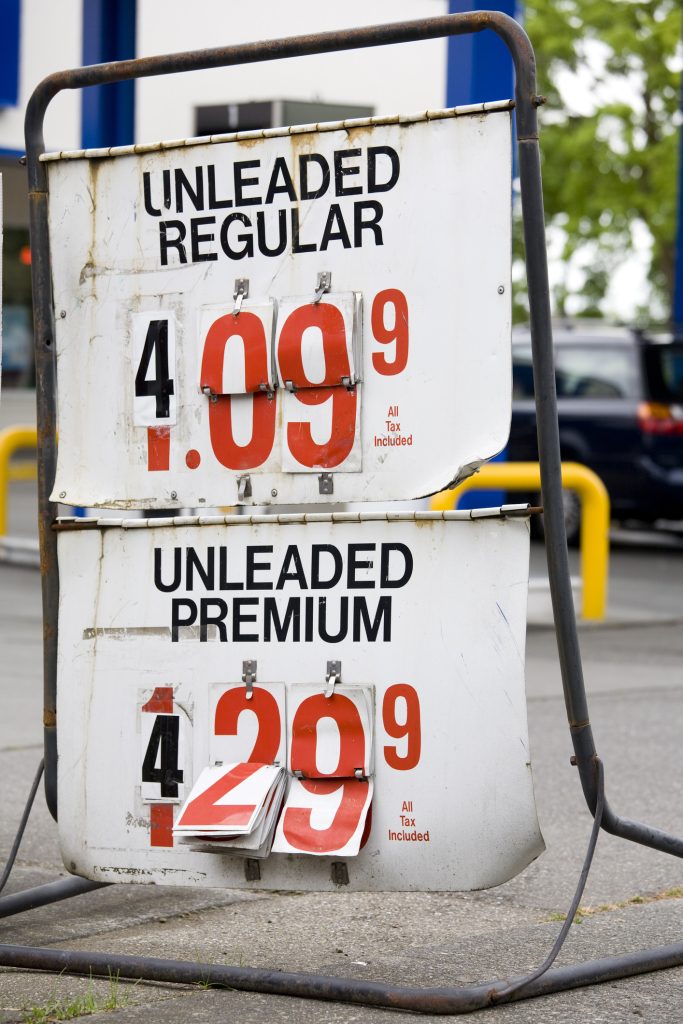
The turn inward in some transatlantic capitals, coupled with spiraling inflation, could lead governments to balk at large, long-term stabilization commitments.
The largely failed stabilization efforts in Afghanistan and Iraq could also contribute to reticence to make a long-term commitment to Kyiv. Both interventions benefited from significant financial, military, and political investments. Yet in both cases, the gains remain fragile, and in Afghanistan, were easily reversed by a Taliban-led insurgency in August 2021. Policymakers, therefore, understandably would ask questions about the potential return on investment for any such large-scale stabilization and reconstruction initiative.
To be sure, Ukraine is not Afghanistan or Iraq in context or problem set. However, perception of what is involved in reconstruction is often reality and must be addressed as part of any effort to advocate for why stabilization is imperative. The United States and Europe will need to clearly and regularly communicate to their publics the direct link between stability in Ukraine and their peoples’ prosperity, as well as the implications for global order and freedom should Putin’s aggression succeed. Victory on the battlefield is not enough.
Toward a framework for the stabilization and reconstruction of Ukraine
This section outlines a framework for stabilization and reconstruction of Ukraine. It begins with an analysis of priority needs and then outlines a set of evidence-based principles, informed by lessons from the last two decades, that can guide stabilization. It concludes with an overview of three scenarios, based on possible pathways for the war and associated recommendations for stabilization and reconstruction.
Pressing needs and priority areas
The Ukrainian government, as with the war generally, is in front of many allies in thinking through challenges looming over the horizon. In July, Ukraine and Switzerland hosted the Ukraine Recovery Conference in Lugano, Switzerland, where forty-one governments and representatives of the Council of Europe, the European Bank for Reconstruction and Development, the European Commission, the European Investment Bank, and the Organisation for Economic Co-operation and Development met to assess Ukraine’s needs and affirm their collective support for meeting them. In tandem with the meeting, Kyiv released Ukraine’s National Recovery Plan , which outlines a road map for rebuilding and modernizing the country with the overarching objective to “grow GDP, and ensure equitable distribution of wealth, and overall well-being.”18Ukraine’s National Recovery Plan, National Recovery Council, July 22, 2022, https://uploads-ssl.webflow.com/621f88db25fbf24758792dd8/62c166751fcf41105380a733_NRC%20Ukraine%27s%20Recovery%20Plan%20blueprint_ENG.pdf.
The resulting Lugano Declaration states that signatories “fully commit to supporting Ukraine throughout its path from early to long-term recovery,” with Ukraine’s National Recovery Plan as “an overarching framework guiding the recovery process” as well as a commitment to principles including transparency, rule of law, and sustainability.19For the Lugano Declaration, see “Outcome Document of the Ukraine Recovery Conference URC2022, Lugano Declaration, Lugano, Switzerland, July 4-5, 2022, https://reliefweb.int/attachments/67d33cee-ad0f-44ec-a780-81f09320ee72/urc2022_lugano-declaration.pdf. The national recovery plan includes a comprehensive set of needs and items that will take years to deliver on, with the ultimate goal of preparing Ukraine legally and institutionally for its eventual EU integration, and building a self-sufficient military system for its national defense.
The Lugano Declaration and the national recovery plan are important steps forward in setting a framework for stabilizing and reconstructing Ukraine. However, the United States, Europe, and Ukrainian leadership need to prioritize immediate needs and develop an actionable strategy for addressing them to get stabilization and reconstruction right and rebuild Ukraine stronger and more aligned with the transatlantic community.
In the immediate term, the international community and Ukrainian government should focus on the following areas, which align with Ukraine’s recovery plan and address the priority end states for stabilization and reconstruction engagement: safe and secure environment; rule of law; stable and representative governance; sustainable economy; and social well-being.
In prescribing these needs, we assume there is a cessation of violence and the government has a monopoly on the legitimate use of violent force, which includes an ability to maintain public order. This assumption applies to areas where the Ukrainian government will begin stabilization work: it can include specific subnational regions and need not include nationwide cessation of hostilities.20Mykhailo Minakov, “Ukraine’s Wartime, Governance Dilemma: Balancing Military and Socioeconomic Needs,” Focus Ukraine, Kennan Institute blog, Wilson Center, May 26, 2022, https://www.wilsoncenter.org/blog-post/ukraines-wartime-governance-dilemma-balancing-military-and-socioeconomic-needs. There is currently a debate between Ukraine and Western donors, with Kyiv advocating that reconstruction and stabilization can begin even before hostilities have ended, while donors are awaiting the cessation of violence. At the time of writing, it appears that the Ukrainian government has already begun “stabilization” measures in areas liberated through its recent counteroffensive,21“Ukraine Working to Stabilize Territory Recaptured in Kharkiv Region, Zelenskiy Says,” Radio Free Europe/Radio Liberty’s Ukrainian News Service, using wire reporting from Associated Press, Reuters, Deutsche Presse-Agentur and Agence France-Presse, updated September 13, 2022, https://www.rferl.org/a/ukraine-russia-battlefield-advances-zelenskiy/32029337.html. including service delivery in the form of payment of pensions.22“President: Stabilization Measures Underway on 4,000 sq km of Liberated Territories,” Ukrinform (Ukrainian multimedia platform for broadcasting), September 13, 2022, https://www.ukrinform.net/rubric-ato/3570864-president-stabilization-measures-underway-on-4000-sq-km-of-liberated-territories.html.
The first focus area is to repair or rebuild basic infrastructure, the damage to which totals $31.6 billion as of the beginning of August 2022.23August 2022 estimates per study by Kyiv School of Economics (KSE) Institute, Ukraine government authorities under the leadership of the Ministry of Reintegration of Temporarily Occupied Territories, and the Ministry for Communities and Territories Development, in cooperation with other ministries and partner organizations under the umbrella of The National Council for the Recovery of Ukraine from the Consequences of the War. See “The Total Amount of Documented Damages Has Reached $108.3 Billion, Minimum Recovery Needs for Destroyed Assets—$185 Billion,” KSE (website), https://kse.ua/about-the-school/news/the-total-amount-of-documented-damages-has-reached-108-3-billion-minimum-recovery-needs-for-destroyed-assets-185-billion/. The government and international backers should focus on rebuilding homes and basic infrastructure including roadways, rail, water distribution systems, bridges, medical facilities, telecommunications (including cyber), and schools. They should prioritize rebuilding the nearly 140,000 residential buildings destroyed due to the fighting, providing temporary housing while construction takes place.24Marc Santora and Peter Baker, “As the Fighting Spreads, 140,000 Residential Buildings Have Been Damaged, Leaving Millions Homeless, Ukraine Says,” New York Times, August 2, 2022, https://www.nytimes.com/live/2022/08/02/world/ukraine-russia-news-war. Roadways required for commerce and other infrastructure required for food delivery systems—from harvesting to storage—should also be prioritized because they are required to restart the economy and deliver basic foodstuffs to the population. This will also critically include focusing on demining necessary for enabling repair and return to reconstructed areas.
The second focus area is to restart basic services in secured areas. In tandem with repairing or rebuilding, the government, with international support, should restart fully stopped basic government services (or calibrate those decreased due to the war) including food and water distribution, medical care, sewer services, education, and transport, among others. Needs will vary depending on the affected area. Stabilization engagement must therefore include support to restart governance structures across the country through which Ukrainian representatives can aggregate and address citizens’ views and needs.
The first focus area is to repair or rebuild basic infrastructure, the damage to which totals $31.6 billion as of the beginning of August 2022.
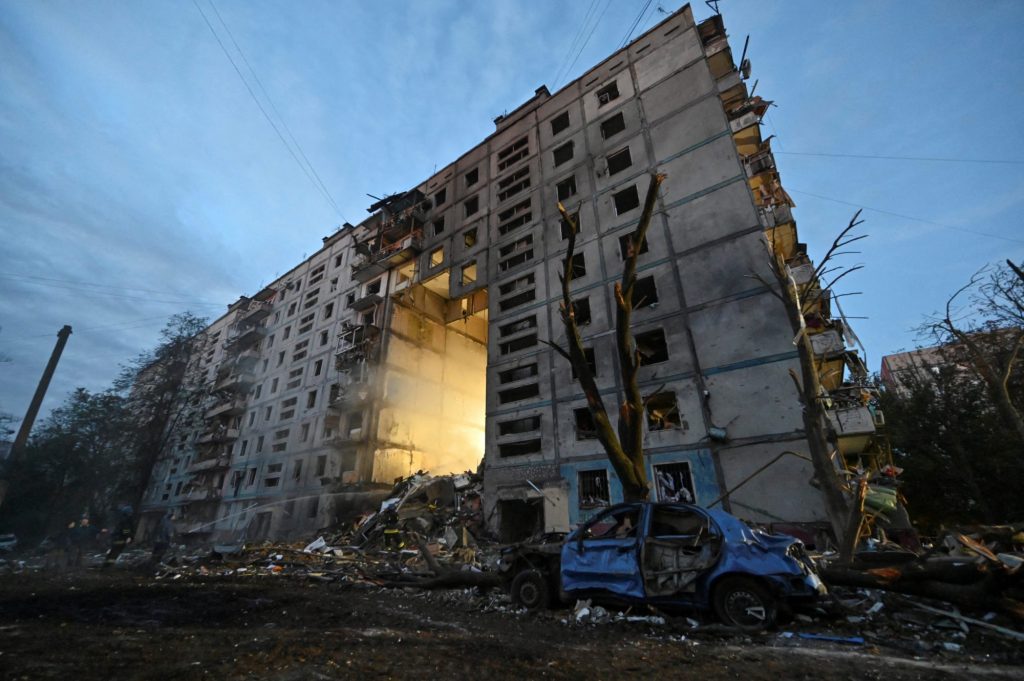
The third focus area is to stabilize the Ukrainian economy by restarting major industries that will be sources of employment and revenue for rebuilding and reconstruction. The United Nations Development Programme reports that one in two businesses have shut down completely.25United Nations, “Ukraine War: $100 Billion in Infrastructure Damage, and Counting,” UN News article (based on UN Development Programme study, The Development Impact of the War in Ukraine: Initial Projections), March 16, 2022, https://news.un.org/en/story/2022/03/1114022. The international community must help provide financing to cover operating costs and salaries of key ministries and arrest Ukraine’s growing budget deficit, which at the time of this writing had reached $5 billion monthly.26Katya Soldak and Forbes Ukraine staff, “Russia’s War on Ukraine: News and Information from Ukraine,” Forbes, August 8, 2022, https://www.forbes.com/sites/katyasoldak/2022/08/08/monday-august-8-russias-war-on-ukraine-news-and-information-from-ukraine/?sh=44872693735f. Financing to help close the deficit gap will be essential to ensure the government can continue providing essential services to the population throughout the war and is ready to begin stabilization and reconstruction in liberated areas.
The fourth focus area is to facilitate the return of Ukrainian refugees who deserve the opportunity to return home and will serve as a vital human resource throughout stabilization and reconstruction. This support could include efforts to enhance security for returnees and provide economic opportunities in both host countries and in Ukraine, as evidenced by studies of the voluntary return of Syrian refugees from Lebanon and Jordan.27Lori Beaman, Harun Onder, and Stefanie Onder, “When Do Refugees Return Home? Evidence from Syrian Displacement in Mashreq,” Journal of Development Economics 155 (2022): 102802. Many refugees have already decided to return despite the ongoing hostilities.28Norwegian Refugee Council, “Ukrainian Homecoming: A Study of Refugee Returns from Poland (July–August 2022), September 5, 2022, https://reliefweb.int/report/ukraine/ukrainian-homecoming-study-refugee-returns-poland-july-august-2022.
Finally, especially considering Ukraine’s stated strategic imperative of EU integration and access to Group of Seven (G7) markets,” Kyiv will likely need to undertake significant institutional reforms and update its regulatory framework. Key priorities for external support would include strengthening the rule of law; continuing its progress on anti-corruption efforts; deregulation; privatizing loss-making state-owned enterprises; streamlining its procurement processes; and initiating land reforms to allow ownership of agricultural land for legal entities.29Marek Dabrowski, “Ukraine: Can Meaningful Reform Come out of Conflict?,” Bruegel Policy Contribution, July 2014, https://www.bruegel.org/sites/default/files/wp_attachments/pc_2014_08_Ukraine.pdf; also see Ukraine Reform Tracker, Economist Impact, Report, 2022, pp 1-61, https://impact.economist.com/projects/ukraine-reform-tracker/; and Ukraine’s National Recovery Plan, pp 1-40. However, some policy changes relating to taxes, state-level administrative reforms, robust anti-corruption measures to transparently coordinate humanitarian aid, and spending would likely need to be pursued even before the cessation of hostilities, in order for Ukraine to sustain its war effort.30Phillip Inman, “Ukraine Needs ‘Radical’ Reform to Sustain War Effort, Warn Economists,” Guardian, September 9, 20222, https://www.theguardian.com/world/2022/sep/09/ukraine-needs-radical-reform-to-sustain-war-effort-warn-economists.
Guiding principles and operational tenets for stabilization and reconstruction
Evidence-based principles must guide international support for stabilization and reconstruction in Ukraine. These principles include operational best practices as well as articulating characteristics in Ukraine that the United States and Europe hope to help realize through their support. The best practices in stabilization and reconstruction are well-documented, and the following are among the most germane to the Ukrainian context.31For a synopsis of these lessons, including from Iraq and Afghanistan and from prior international stabilization engagement as well, see the following key works (among others): Stabilization Assistance Review: A Framework for Maximizing the Effectiveness of U.S. Efforts to Stabilize Conflict Affected Areas; United States Strategy to Prevent Conflict and Promote Stability, Departments of State and Defense and USAID, 2020; The UK Government’s Approach to Stabilization: A Guide for Policy Makers and Practitioners, UK Stabilization Unit, 2014; Patrick Quirk and Jason Fritz, “Contested Stabilization: Competing in Post-Conflict Spaces,” Brookings Institution, May 2020; Stabilization: Lessons from the U.S Experience in Afghanistan, Special Inspector General for Afghanistan Reconstruction (SIGAR), 2018; all other SIGAR reports; and Frances Brown, “Dilemmas of Stabilization Assistance: The Case of Syria,” Carnegie Endowment for International Peace,” October 2018.
Strategy: A theory of success for stabilizing Ukraine
The United States and Europe, which will be in the lead in generating funding for stabilization and reconstruction, must articulate a strategy. We define strategy as a theory of success.32For an overview of the main elements a US strategy should entail, see Jeffrey Meiser and Patrick Quirk, “Want Better Strategists? Start With a Better Definition of Strategy,” Real Clear Defense, July 9, 2020, https://www.realcleardefense.com/articles/2020/07/09/want_better_strategists_start_with_a_better_definition_of_strategy_115451.html. A theory is an explanation of how and why proposed actions will cause desired outcomes. Therefore, the strategy must include a clear statement of goals (what you want to cause), the specific proposed actions to achieve those goals, and the causal logic that connects actions to outcomes.33Patrick W. Quirk and Jeffrey W. Meiser, “Creating a Political Strategy for Stabilizing Fragile States,” Order from Chaos (series), Brookings, January 28, 2020, https://www.brookings.edu/blog/order-from-chaos/2020/01/28/creating-a-political-strategy-for-stabilizing-fragile-states/.
The strategy’s goal should articulate the desired political end state in Ukraine once stabilization is complete. The strategy should cover a multiyear period, noting the enormity of the challenge and the shortcoming of shorter planning experienced by the United States and others in Afghanistan, Iraq, and other stabilization engagements. It must explicitly outline plans for burden sharing and division of labor between the United States and Europe, and how shorter-term stabilization efforts will transition to longer-term development, and then to Ukrainian government control.
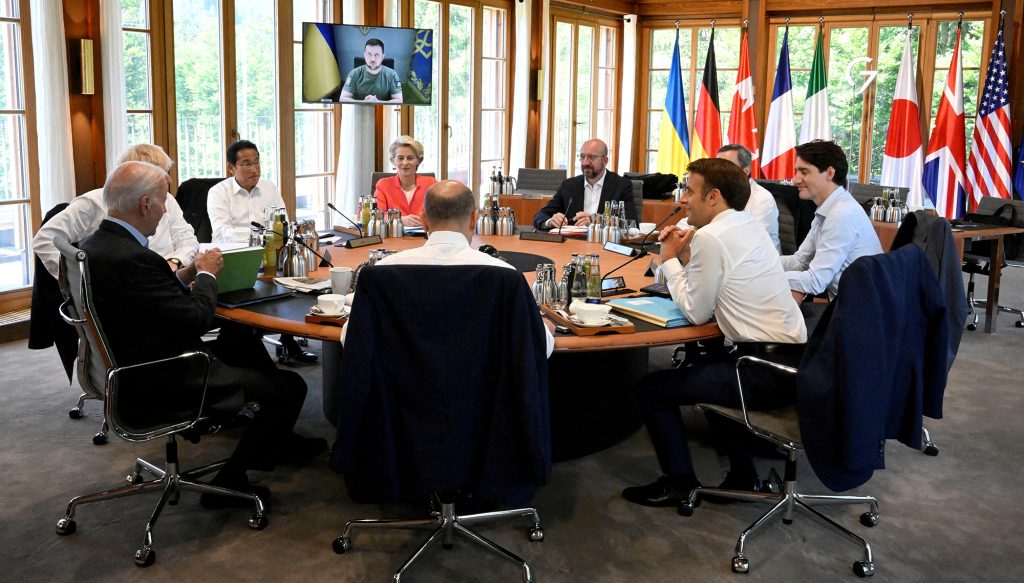
In setting an end goal for stabilization and reconstruction, Ukraine and its partners should conceptualize what Ukraine should look like—independently and vis-à-vis its relationship with the West—at the end of any stabilization and reconstruction support.
In determining where to begin stabilization and reconstruction, Ukraine and its partners should first prioritize liberated areas where security is permissive for undertaking stabilization.34The Ukrainian government has four categories (for areas in eight regions): front line; support; deoccupied; and back line. They should reinforce and build out from these areas, rather than prioritizing localities that could soon be contested again.35Focusing on secured areas and building out from them is a key finding and recommendation of the US government’s Stabilization Assistance Review: A Framework for Maximizing U.S. Efforts, and a key finding of much of SIGAR’s work examining the failings of US stabilization efforts in Afghanistan. The United States and Europe should apply lessons from analysis of their stabilization work globally—from Afghanistan to Mali—indicating that security is a vital precursor to stability.
The stabilization and reconstruction of Ukraine should seek to align security, development, humanitarian, and diplomatic efforts.36SIGAR, What We Need to Learn. A sobering lesson from past stabilization and reconstruction efforts suggests that the commitment of resources was disproportionately in favor of the military; meanwhile, the politics of stabilization (e.g., aid coordination, state building, and governance reform) was sidelined and implemented haphazardly. Stabilization is an inherently political endeavor, and therefore requires substantial diplomacy at the national and subnational levels. Additionally, a lack of ownership at the national, subnational, and local level hampered institutional reforms and led to poor coordination among international community members, the state, and the community meant to be served by intervention. Approaching stabilization right in Ukraine thus necessitates starting early, engaging the Ukrainian state as the face of all efforts, and prioritizing the political as much as the military aspects of the war.
In setting an end goal for stabilization and reconstruction, Ukraine and its partners should conceptualize what Ukraine should look like—independently and vis-à-vis its relationship with the West—at the end of any stabilization and reconstruction support. These include realizing a Ukraine that is integrated into the West, even if not yet a full member of the European Union or a member of NATO, and that supports democracy as the foundation for governance. Its institutions should be democratic, with governance systems that are responsive to citizens. The vision for postwar Ukraine should be developed in close consultation with local communities and civil society groups. Such inclusion, especially of underrepresented groups, women,37Marie O’Reilly, “Why Women? Inclusive Security and Peaceful Societies,” Inclusive Security (website), October 2015, https://www.inclusivesecurity.org/publication/why-women-inclusive-security-and-peaceful-societies/. and youth, is proven to improve long-term stability of outcomes, and builds ownership of the transition and reconstruction effort.
Actors, funding, coordination, and division of labor
No matter the scenario, the United States, allies, and Ukraine should employ a common set of operational features including funding mechanisms and coordination for stabilization efforts to be successful.
The United States and Europe are already providing a significant amount of assistance to Kyiv. The United States’ assistance efforts to date have ranged from providing direct military assistance to Ukraine to bolster its defense and to simultaneously increase the cost of invasion for Russia, to economic and humanitarian assistance with the intent to help Ukraine resurrect its economy.
Actors. The following are some of the most prominent of these efforts by major actors.
US approaches:
- Direct military support to defend against the Russian invasion has included $6.9 billion of security assistance to Ukraine, including sixteen critical high mobility artillery rocket systems (HIMARS), national surface-to-air missile systems (NASAMS), artillery ammunition, counterartillery radars, and other equipment.38For a breakdown of security assistance provided by the United States, see “Fact Sheet on U.S. Security Assistance to Ukraine,” US Department of Defense, News Release, July 5, 2022, https://www.defense.gov/News/Releases/Release/Article/3083102/fact-sheet-on-us-security-assistance-to-ukraine/#:~:text=The%20United%20States%20has%20committed,unprovoked%20invasion%20on%20February%2024; and, https://www.state.gov/u-s-security-cooperation-with-ukraine/.
- Direct financial support to Ukraine’s government has totaled $8.5 billion.39The total budget approved by the US Congress is higher than what’s initially earmarked; see Bianca Pallaro and Alicia Parlapiano, “Four Ways to Understand the $54 Billion in U.S. Spending on Ukraine,” New York Times, May 20, 2022, https://www.nytimes.com/interactive/2022/05/20/upshot/ukraine-us-aid-size.html; and USAID, “The United States Contributes $4.5 Billion to Support the Government of Ukraine,” News Release, August 8, 2022, https://www.usaid.gov/news-information/press-releases/aug-08-2022-united-states-contributes-45-billion-support-government-ukraine.
- This support is geared toward enabling the Ukrainian government and civil society respond to the critical priorities shaped by the Russian invasion. It includes humanitarian assistance for internally displaced people in East Ukraine and Kyiv Oblast (or province).40USAID, “The United States Contributes $1.3 Billion to Support the Government of Ukraine,” News Release, June 30, 2022, https://www.usaid.gov/news-information/press-releases/jun-30-2022-united-states-contributes-13-billion-support-government-ukraine#:~:text=The%20United%20States%2C%20through%20the,intends%20to%20provide%20the%20Ukrainian.
- Notably, several of these nonmilitary measures build off the Ukrainian Confidence Building Initiative (UCBI) program that was launched by the US government (specifically by the US Agency for International Development/Office of Transition Initiatives) in 2014 to support the development of an inclusive Ukrainian identity and to enhance citizen confidence and engagement in the local reform process. USAID has provided general surge support since the beginning of the invasion to respond to its impacts and assist the local government in delivering essential services.41“Ukraine,” USAID (website), What We Do (section), accessed October 2022, https://www.usaid.gov/stabilization-and-transitions/ukraine.
The United States and European Union should each establish a fund for stabilization and reconstruction to be managed with Ukraine.
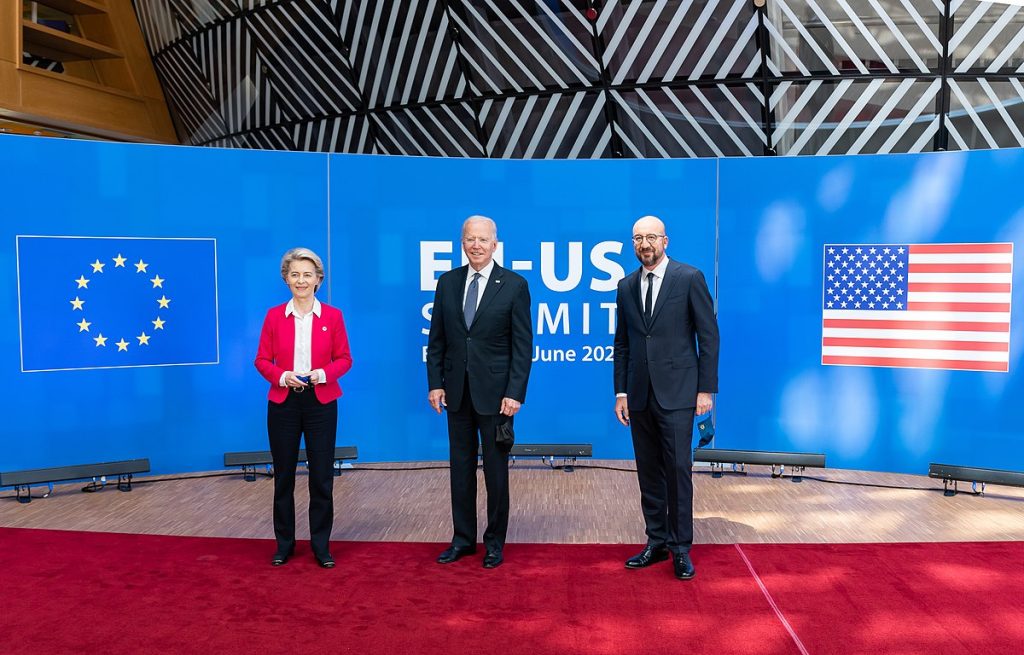
European approaches:
- The European Investment Bank (EIB) has pledged €1.59 billion ($1.55 billion) in reconstruction assistance for Ukraine.42For details on the estimated costs of assistance to Ukraine and the amounts disbursed, see Piotr Buras et al., “Survive and Thrive: A European Plan to Support Ukraine in the Long War against Russia,” European Council on Foreign Relations, Policy Brief, September 9, 2022, https://ecfr.eu/publication/survive-and-thrive-a-european-plan-to-support-ukraine-in-the-long-war-against-russia/.
- The European Commission has pledged emergency loans of up to €10.2 billion in macrofinancial assistance to Ukraine.43Buras et al., “Survive and Thrive: A European Plan to Support Ukraine.”
- EU member states have received Ukrainian refugees, providing support totaling €20 billion.44Alan Rappeport, “G7 Nations Pledge $20 Billion to Ukraine, New York Times, May 20, 2022, https://www.nytimes.com/2022/05/20/business/economy/g7-20-billion-ukraine.html.
- Humanitarian aid for Ukraine from the European Commission totaling €335 million is for food, shelter, healthcare, and water.45For a breakdown of this assistance, see “European Civil Protection and Humanitarian Aid Operations: Ukraine Fact Sheet,” European Commission (website), last updated August 26, 2022, https://civil-protection-humanitarian-aid.ec.europa.eu/where/europe/ukraine_en#:~:text=Since%2028%20February%2C%20the%20European,%E2%82%AC13%20million%20for%20Moldova.
- An EU fund for military assistance (European Peace Facility) has provided €2 billion for the Ukrainian armed forces,46More details are available in an article by Hans von der Burchard, “EU to Increase Military Support Funding for Ukraine to €2 Billion,” Politico, May 13, 2022, https://www.politico.eu/article/eu-to-increase-military-support-fund-for-ukraine-2-billion/. allowing Kyiv to procure weapons and equipment.
- European officials and experts will gather at an October 26 conference in Berlin, as European Commission and EU members’ leaders look for areas where they can make precise and speedy contributions.47“Berlin to Host International Donors Conference on Ukraine Reconstruction Oct 25,” UKRINFORM (platform), October 9, 2022, https://www.ukrinform.net/rubric-polytics/3549111-berlin-to-host-international-donors-conference-on-ukraine-reconstruction-oct-25.html.
International organizations: International finance institutions like the World Bank have also mobilized $13 billion of emergency support to Ukraine, out of which $11 billion has been disbursed.48See “World Bank Mobilizes Additional $530 Million in Support to Ukraine,” World Bank Press Release, September 30, 2022, https://www.worldbank.org/en/news/press-release/2022/09/30/world-bank-mobilizes-additional-530-million-in-support-to-ukraine#:~:text=To%20date%2C%20the%20World%20Bank,billion%20has%20been%20fully%20disbursed.
These actors will need to focus on the following three core tasks to advance stabilization and reconstruction:
Funding. The United States and European Union should each establish a fund for stabilization and reconstruction to be managed with Ukraine. The United States and the EU can invite allies to either make contributions to one of the two funds or establish their own. Funds should be provided as grants, not loans, to avoid saddling Ukraine with additional debt, and be guided by Ukraine’s vision for what the country should look like in the future. While Ukraine should provide the vision, Washington and Brussels should establish parameters for receipt of funding. These should include, as outlined in the Lugano Declaration, strong anti-corruption measures; a stated desire to use monies to modernize infrastructure (i.e., replace existing Soviet era buildings or roadways); agreed amounts that Ukraine will mobilize domestically to fund reconstruction; and a planned handoff of activities to Ukraine once specified benchmarks have been met.
The US and EU funds would complement support that the World Bank provides, which should center on transferring financing to cover Ukraine’s budget deficit and line ministry costs, and the Multi-Donor Trust Fund for Ukraine (MDTF), established to support provision of social services. The United States and Europe can continue contributing funds to the MDTF, which can be the pillar to maintain social services (i.e., gas, water, electricity), and center their own funds on stabilization and reconstruction.49See World Bank, World Bank Group Response to Global Impacts of the War in Ukraine: A Proposed Roadmap, April 12, 2022, https://thedocs.worldbank.org/en/doc/bf544fb23105352f4aef132bd6f40cb8-0290032022/original/WBG-Response-to-Global-Impacts-of-the-War-in-Ukraine-A-Proposed-Roadmap.pdf.
The United States and the EU should direct private and philanthropic capital to the American or European funds and discourage bilateral donations as much as feasible. Channeling funding through institutionalized funds managed by donors and guided by the Ukrainian government will increase the probability said monies help solve priority issues and are not siphoned off as graft. If companies or high-net-worth individuals are loath to make such contributions, the United States, EU, and Ukraine can direct them to make in-kind donations by purchasing materials or other items called for in stabilization and reconstruction plans.
Channeling funding through institutionalized funds managed by donors and guided by the Ukrainian government will increase the probability said monies help solve priority issues and are not siphoned off as graft.
Coordination. Within the US government, the Department of State’s Bureau of European and Eurasian Affairs should lead in setting US strategy and working with the government of Ukraine to define and meet needs. The Bureau’s Office of the Coordinator of US Assistance to Europe and Eurasia should oversee assistance allocations. The department’s Bureau of Conflict and Stabilization Operations is best positioned to provide analysis, strategy development, and impact measurement support from both Washington and the field. The US Agency for International Development’s Bureau of Conflict Prevention and Stabilization will play an important role in scoping and helping implement key stabilization projects. These entities, with guidance from the White House, would coordinate directly with their Ukrainian government counterparts, likely in the Office of the President in Kyiv, and those in Brussels.
The United States and the government of Ukraine should work together to define priorities and implementation plans for utilizing monies, in line with the overall stabilization strategy for the country. As needed, coordination could be extended to G-7 countries.
Division of labor. The United States and the EU should work with Ukraine to devise an actionable division of labor for stabilization and reconstruction. This could be based on sector or, more ideally, based on geography: for example, in the immediate term, the United States fund could focus stabilization and reconstruction on the Kyiv region while the fund led by the EU could focus on Chernihiv. A common goal for Ukraine would enable Washington and Brussels to set a division of labor and execute the work plan. It is essential that the stakeholders involved in this effort have shared timelines and to communicate them to their domestic publics. Past experiences in postwar reconstructions have proven that these are long-term, complex efforts that require sustained investments.
War scenarios and policy recommendations
The war in Ukraine could take one of several pathways, ranging from Ukraine winning decisively and reclaiming all territory to the converse, with Russia winning outright. Outlining stabilization and reconstruction recommendations for all potential scenarios is beyond the scope of this paper. Instead, we offer policy guidance for three of the more probable scenarios (at this time of this writing) for the next three to six months.
Given the volatility in any war and several geopolitical events that could potentially alter the course of the war, these scenarios are formulated as a pragmatic approximation of likely events. For each scenario, we offer policy guidance in the form of steps Ukraine and the transatlantic community should take—guided by the framework and broader operational tenets outlined above—for stabilization and reconstruction.

Scenario 1: The war continues in its current tempo
Description, implications, and policy guidance
The war continues in its current tempo, with the country de facto divided into Ukrainian and Russian-occupied territory.
The first and most likely scenario entails a continuation of the current tempo of armed hostilities. The war continues without a cease-fire and a negotiated settlement because Russia, Ukraine, Europe, and the United States can absorb the military, economic, and social costs of war. They can bear the direct and indirect costs of sanctions imposed on Russia. All major parties to the war—Ukraine, Russia, the EU, and the United States—are also able to defend the continuation of armed hostilities to their respective electorates.
This scenario would resemble a stalemate that could endure for several months, possibly for years. It could translate into parts of Ukrainian territory experiencing active military confrontation, whereas other parts being relatively quiet yet still in a war. Some parts of Ukraine may be characterized by contested legitimacy, with Russia claiming sovereignty because it annexed them, such as Crimea in 2014 and Donbas in 2022, and Ukraine and most of the Western world recognizing those areas as part of Ukraine.
Under this scenario, Putin is likely to keep Russia militarily engaged in Ukraine for the foreseeable future and accept the military and economic costs of doing so. Russia is likely to continue to use artillery as its dominant tactic and test the resolve of the West to stay the course in Ukraine. The Russian military may not be able to neutralize the Ukrainian military outside the Donbas region and the Ukrainian resistance may not be able to repel Russia to its pre-February 24 position. The West would also remain undeterred in its support for Ukraine, despite the economic cost of war.
Implications
While there is unlikely to be an outright victory for Russia, it will possibly reap benefits from its de facto control of areas that it occupied. Similarly, Ukraine would likely continue mounting a sturdy defense across most of the front lines but without meaningfully repelling Russia from the East and the South. This scenario will pit the durability of Ukrainian resistance, bolstered by Western support, against the capacity of Russian military mobilization.
Hostilities will persist and the country would be de facto divided into Ukrainian sovereign land and Russian occupied territories in the South and the East. In line with this scenario, Putin has already held referenda in the areas captured by Russia, seemingly with the intent to formally annex them. These areas in the Donbas region may operate autonomously, but will likely be diplomatically and economically integrated with Russia.
Policy guidance
- Retain focus on marshaling support and military-assistance transfers to Kyiv sufficient to enable it to win.
- Increase the lethality of military assistance transferred to include fighter aircraft that would enable Ukraine to control its airspace and attack Russian forces therein; and missile technology with range sufficient to reach into Russian territory for the purpose of preventing further incursions by disrupting supply lines and destroying Russia’s military forces, both personnel and equipment.
- Initiate and expand stabilization and reconstruction in areas held by Ukraine, with a focus on priority areas outlined in prior sections, to include establishing order, providing public services, and strengthening local governance institutions.
- Create permissive conditions and logistical pathways for Ukraine to export grain and revitalize its economy.
- Buttress Ukrainian defenses on the front lines, near the Donbas region. This may entail providing combat training focusing on irregular warfare, artillery, and offensive capability to disrupt Russia’s logistics.
- Work closely with regional and multilateral organizations to negotiate for political neutrality in the Russian-controlled territories (such as in the Donbas) of Ukraine.
- Ratchet up the economic costs on Russia by imposing secondary sanctions on all entities doing business with the Kremlin.
- Confiscate the $300 billion that the Russian state holds in overseas accounts in the United States and EU and use seized monies to fund reconstruction.1Eliot A. Cohen, “Russia’s Nuclear Bluster Is a Sign of Panic,” Ideas, Atlantic, October 4, 2022, https://www.theatlantic.com/ideas/archive/2022/10/putin-nuclear-weapons-threat-us-sanctions-military/671642/.
- Train Ukrainian military to use Western weapons, electronic warfare, and offensive and defensive cyber capabilities, and to seamlessly integrate new recruits in the service.
- Coordinate with NATO and other allies to establish channels of communication with Ukraine for joint threat assessments, military resource assessments, and contingency planning.

Scenario 2: A negotiated settlement between Russia and Ukraine
Description, implications, and policy guidance
A negotiated settlement between Russia and Ukraine returns some territory to Ukraine.
The second and less likely scenario of a negotiated settlement could come about if the West continues to ratchet up sanctions on Russia and increases its costs of war, perhaps making the Russian regime more amenable to a face-saving way to declare partial victory and end the hostilities. Any prospect of a settlement would likely involve protracted negotiations and third-party mediators. There is low probability of this scenario coming to pass, however, given that the cost of sanctions have not dramatically altered Russia’s momentum, and the Ukrainian public remains increasingly opposed to offering any concessions to the Kremlin.
Implications
A negotiated settlement, in the short term, could translate into either a mutually beneficial agreement for all major parties to the conflict, or a détente, as in the Korean peninsula. Regardless of the form it takes, a cessation of armed hostilities would likely result in stemming the flow of refugees and a decline in fuel prices. It would also allow for an introduction of mutually agreeable, probably UN-mandated, peacekeeping forces in Ukraine and in the Russian-occupied territories of Ukraine.
Policy guidance
- Address the key priorities for stabilization such as rebuilding basic infrastructure, restarting the provision of public services, and resuscitating the Ukrainian economy throughout areas held by Kyiv, with the expectation that similar stabilization processes can be undertaken in areas that are de facto under Russian control.
- Respond to the most urgent humanitarian needs triggered by the need to resettle and access healthcare and water. This will include providing support to both the Ukrainian returnees and to Ukrainian IDPs. This initiative should be coordinated between the United States, the EU, and the Ukrainian government. As hostilities wane, organizations like the United Nations High Commissioner for Refugees and UN Office for the Coordination of Humanitarian Affairs can be engaged to provide longer term support to coordinate emergency response and facilitate the logistics for resettlement of Ukrainians displaced by war.
- Strengthen the cohesiveness of the Ukrainian society residing both inside Ukraine-controlled Ukrainian territory and Russian-occupied Ukraine. This should be led exclusively by the Ukrainian government and involve both assimilation and accommodation strategies that are employed by states trying to integrate minorities into their national story.2Harris Mylonas, Adria Lawrence, and Erica Chenoweth, “Assimilation and Its Alternatives: Caveats in the Study of Nation-Building Policies,” Journal of Southern Europe and the Balkans 2 (2010): 141-48.
- Organize key donors such as USAID, the UK’s Department of International Development, and the World Bank to bolster subnational governance in Ukraine to better respond to citizens’ needs. This would be critical to go beyond the most urgent needs and start developing political and economic institutions that are more accountable to the Ukrainian citizenry. Previous reforms, especially those initiated since 2014, have been promising, though there is significant subnational variation in the success of those reforms.3For more details on the progress of administrative, governance, and economic reforms, see Ukraine Reform Tracker. The face of this effort will be the Ukrainian government.
- Neutralize potential spoilers to the peace agreement including external factors such as Moscow’s disinformation efforts or cyber threats and internal ones such as pro-Russian groups in Ukraine. This would entail identifying them, in partnership with the Ukrainian government, and calibrating a deliberate plan to either deter those spoilers or co-opt them.
- Pursue opportunities for reconciliation and reintegration at the grassroots level, especially for the Russian-speaking population. Such efforts could include initiatives that strengthen their economic self-sufficiency, engagement of social workers to address their psychosocial well-being , and enabling their access to local services.
- Undertake a concerted effort in security-sector reform over a one-to-three-year timeframe to ensure that the institutions that are responsible for provision of security and establishment of order are transparent, and that they institutionalize principles of public engagement, accountability, and respect for human rights. These reforms should also include strengthening the legal and budgetary frameworks for governing the security sector.

Scenario 3: A limited Ukrainian victory and a reinstatement of pre-February 24 borders
Description, implications, and policy guidance
A limited Ukrainian victory results from a withdrawal of Russia and a reinstatement of the pre-February 24 borders.
The third scenario is the least likely one to occur over the prescribed period of 3-6 months . It is possible, however, that the escalating costs of war over the next one to three years would sufficiently weaken the morale of the Russian war commanders, stretch Russian supply lines, impede Russia’s plans to seize the entire region of Donbas, and simultaneously trigger a grave economic crisis in Russia. Simultaneously, the West would continue to absorb the economic and political costs of war and afford to subsidize the price of consumption goods, thus continuing its support for Ukraine, most visibly through military and economic assistance.
Seizing this opportunity unleashed by continued Western support and weakening resolve in Moscow, Ukraine could go on the offensive and target areas where the Russian military is vulnerable and/or underresourced. If this were to happen, it is possible that Ukraine could push Russia into accepting its territorial borders as they existed on February 24, 2022.
Implications
Pushing Russia to the pre-February 24 boundaries will not enable Ukraine to reclaim Crimea or secure Donbas, nor will it permanently end Putin’s militarism in Ukraine. But it would likely enable Ukraine to declare a partial victory and signal the importance of coordinated resistance as an effective armor against a vastly superior adversary.
The end of armed hostilities, as projected in this scenario, would likely open up avenues for stabilization, depending on the scale of destruction unleashed by war.
Policy guidance
- Address the humanitarian crisis caused by war, provide basic services to Ukrainians, and help the Ukrainian state establish order across its sovereign territory.
- Strengthen Ukrainian defenses against future Russian militarism through continued supply of military assistance, training, and technology transfer. Ensure, through augmented military transfers, that Ukraine can deter future Russian aggression.
- Integrate Ukraine under the security umbrella of the West, most formally as a NATO member.
- Initiate political reform in the country to help the Ukrainian state integrate the Russian-speaking population into its nation-building process through accommodation. This process should focus on those Russian-speaking communities that have either supported Russia or sat on the fence. The process can entail granting them special minority rights and establishing institutions that safeguard those rights.4Mylonas, Lawrence, and Chenoweth, “Assimilation and its Alternatives.”
- Provide advisory support and foster investment to help Ukraine calibrate its economic base to one with more lucrative and sustainable industries. The war destroyed its industrial base in the East and South. The West can help incentivize the development of steel production, arms manufacturing, and auto and aerospace industries in western and central Ukraine; much of Ukraine’s industrial base has already moved to Lviv Oblast.5A 2014 analysis by Richard Connolly of the University of Birmingham looked at potential economic differences in a Ukraine divided along ethnic lines; see “A Divided Ukraine Could See Two Radically Different States Emerge,” Conversation (nonprofit news organization), March 3, 2014, https://theconversation.com/a-divided-ukraine-could-see-two-radically-different-states-emerge-23946.
- Help Ukraine integrate its energy policy with that of the EU. This would entail development of indigenous sources of energy, especially given Russia’s control of the Zaporizhzhia nuclear power plant. It would also include increasing domestic energy efficiency and diversifying its energy production.
- Assist Ukraine’s transition to Western defensive and offensive military systems and technologies over the next one to three years, primarily by incentivizing major private defense suppliers to forge partnerships with Ukrainian firms.
Conclusion
Western support for Ukraine remains imperative, especially as Russia continues escalating the war and raising the stakes of this regional conflagration. However, as crucial as the military and immediate financial assistance is for Ukraine to survive by winning the war against Moscow, it is not enough. Ukraine needs a full-fledged postconflict road map that can give it a chance for long-term security and prosperity, and help her reintegrate into a transatlantic community that is at peace. A reconstruction and stabilization plan is therefore essential, and the transatlantic community has a moral and strategic imperative to assist in its implementation.
This issue brief is taking the first steps toward this goal by providing a set of comprehensive principles for how transatlantic actors, with Ukrainian leaders in charge, should approach the country’s stabilization and reconstruction. Additionally, the policy guidance provided can help transatlantic policymakers plan around the existing volatility and unpredictability surrounding the conflict, and assist Ukrainian leaders and civil society in laying down the groundwork for the “day after” the war in their country, whatever that may look like.
The risk of a wilting global consensus on the need to remain committed to assisting Ukraine cannot be underestimated. Additionally, there are likely to be steep political costs for continued commitment from the United States, its European partners, and other members of the international community. Despite these challenges, the West has a unique opportunity to rally long-term commitment toward an ambitious goal and set the stage now for shaping a different future in Ukraine, and therefore in the transatlantic arena.
By addressing the limitations of previous stabilization imperatives in Iraq, Afghanistan, and elsewhere, engaging key actors early and intentionally, and co-creating a road map for stabilization with Ukrainian partners, the West can strengthen the prospects for Ukrainian, Euro-Atlantic, and global security. The time is now.
Dr. Patrick Quirk is a Nonresident Senior Fellow in the Atlantic Council’s Scowcroft Center for Strategy and Security and Senior Director for Strategy, Research, and the Center for Global Impact at the International Republican Institute (IRI). Previously, Dr. Quirk served on the US Secretary of State’s Policy Planning Staff as the lead advisor for fragile states, conflict and stabilization, and foreign assistance; and was a lead author of the US government’s Stabilization Assistance Review (SAR).
Prakhar Sharma is Senior Researcher at IRI, where he specializes in conflict prevention and stabilization.
Related expert
Related program
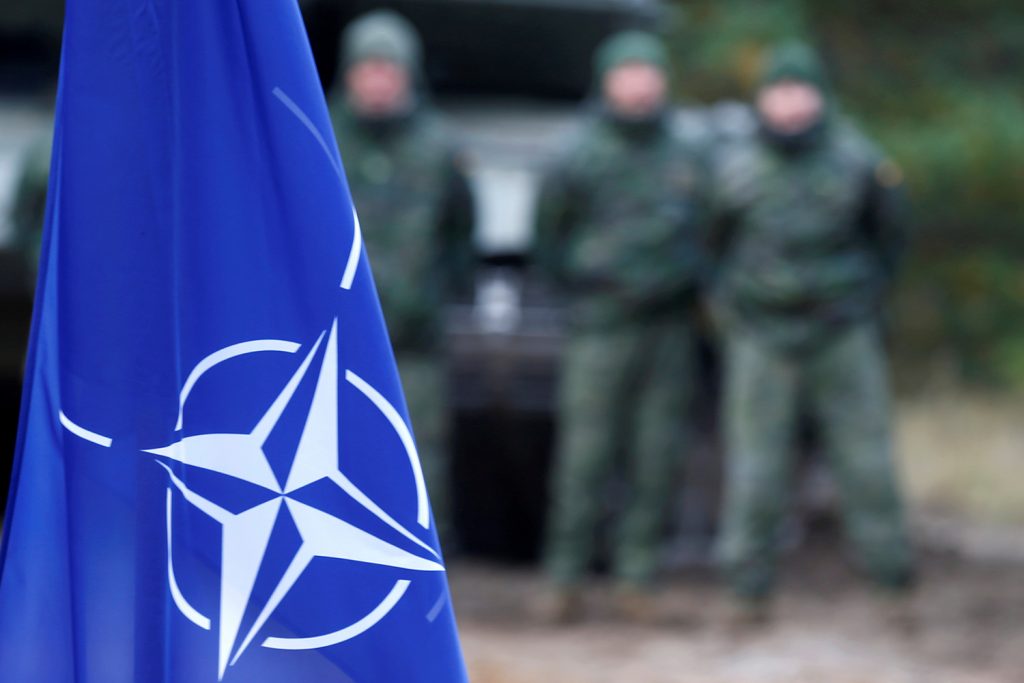
The Transatlantic Security Initiative, in the Scowcroft Center for Strategy and Security, shapes and influences the debate on the greatest security challenges facing the North Atlantic Alliance and its key partners.
Related content
Image: A fresh hole is seen ahead of a funeral, among dozens of recent graves of people who have died since the beginning of Russia's invasion, in the Walk of Heroes section of the cemetery, where people who served as military members, fire fighters and police officers are buried, as Russia's attack continues, in Kharkiv, Ukraine, July 2, 2022. REUTERS/Leah Millis

